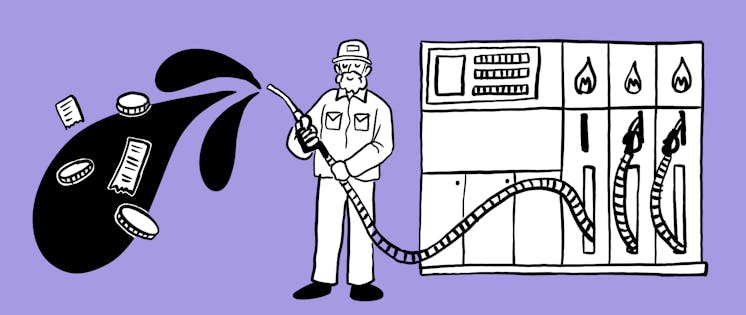.png?ixlib=gatsbyFP&auto=compress%2Cformat&fit=max&w=2480&h=1046)
Mechanics tax rebate: Don’t let your tool tax throw a spanner in the works
Thinking about a mechanics tax rebate is probably the last thing on your mind after a busy day at the garage.
But as a mechanic, if you have a uniform, professional subscriptions, tools and equipment to do your job you could be eligible for a lot more than you might think.
Let’s take a closer look at what exactly a tax rebate for mechanics is, what makes you eligible and how to go about getting it.
(Without having to change professions from mechanic to accountant.)
Content overview
What is a mechanics tax rebate?
A tax rebate is simply a refund of money from the taxman, to make up for necessary business expenses.
A mechanic’s tax rebate is usually for tools, uniforms, mileage or professional subscription fees that you’ve had to shell out for to do your job.
You’re eligible to claim a tax rebate for mechanics if you’ve:
- Bought your own tools and equipment for your job
- Cleaned and laundered your own uniform (away from the workplace)
- Paid for your own HMRC-approved professional subscription service
- Have to drive to different locations to see clients
- Do not receive full reimbursement for any of the above from your boss
Sound good so far?
What methods can I use to claim my mechanic’s tax rebate?
There are two main ways you can claim a tax rebate for mechanics:
- Using the government’s flat rate
- Making a capital allowances claim
You can use both methods regardless of whether you’re PAYE (Pay As You Earn) or self-employed.
Using the government’s flat rate
The government assigns a flat rate of £120 to mechanics, meaning you can claim a maximum of £120 a year for all your tools and uniform expenses. You can also claim professional subscription costs and mileage fees in addition to the flat rate.
Making a capital allowances claim
If you’ve spent more than the flat rate on tools, then you can make a capital allowances claim. With a capital allowance claim, you can expect to get back around 20% of your spending on tools and equipment as a tax rebate.
To make a capital allowances claim, you must keep a record of what you’ve spent on tools. This can look like:
- Receipts
- Email order confirmations from websites like Amazon or eBay
- Full purchase history from tool shops like Snap-On or Mac
Again, the cost of your professional subscription service and your mileage can be claimed in addition to your tools and equipment.
Which expenses, tools and equipment qualify for a mechanics tax rebate?
There are a few rules and regulations around what qualifies for a mechanics tax rebate. Allow us to explain…
Uniform
If you’re responsible for washing, repairing or replacing your uniform, then you may be entitled to a uniform tax return.
But there are a few provisos:
- Your uniform has to qualify as uniform under HMRC guidance
- You can’t claim for the initial purchase of the uniform, only repairs, replacements and laundry
- Your employer cannot reimburse you for the cost of caring for or replacing your uniform
- Your employer cannot provide the laundry services
HMRC guidance states that a “uniform is a set of specialised clothing that identifies someone as having a particular occupation, for example, nurse or police uniforms”. They go on to explain it is not everyday clothing you wear for work (even if you have to wear a certain design or colour).
Remember that you’re never eligible to file a uniform tax return for PPE as your employers have to supply that for you, or reimburse you for the cost.
Check out our article on HMRC uniform tax article to find out more about what you can claim for uniform wise.
Tools and equipment
If you’re buying or replacing your tools or equipment that’s another area where you can claim your mechanic tax rebate.
The tools or equipment must be wholly necessary to your job and not provided by your employer. For example, if you buy a specific type of hammer, but your employer has already provided that exact kind of hammer, that is not something you can claim.
To claim you must also:
- Have paid enough in tax to cover the amount you’re asking for
- Have bought tools that are wholly necessary to do your job
- Fully own the tools (not lease them)
- Not have been reimbursed in full by your employer for your tools
If you’ve been partially reimbursed by your employer you can claim back the amount you have not been reimbursed for. If you have bought your tools on credit, you can still claim them back, including any interest you’ve paid.
Not too shabby, ey?
Membership and subscription fees
If you pay for a professional subscription that HMRC approves of that’s another area you can claim a mechanics tax rebate.
Some more great news: It’s separate from the £120 flat rate!
So if you pay for membership to a society that’s on HMRC’s super special list, like the Institute of the Motor Industry (IMI), then you’re eligible to claim it on your tax rebate.
Take a look at our article on HMRC professional subscriptions to find out everything you need to know about making a claim.
Mileage
If you end up doing a fair amount of driving in your role as a mechanic then your fuel costs are another thing you can claim back.
If you’re driving for business purposes then you can claim back a certain amount of pennies per mile as a business expense. Unfortunately, your everyday commute to the same office or garage cannot be reimbursed, or trips that are a short distance (which is usually defined as under 10 miles).
For cars and vans, HMRC set their mileage rate at £0.45 per mile when driven under 10,000 miles per year. Anything above 10,000 miles per year drops to £0.25.
Claims under £2,500 can be made using the P87 HMRC form. Alternatively, claims over this amount will have to be made through self-assessment.
Take a look at our article on HMRC mileage rates to discover exactly how much you could be claiming.
Can you backdate your mechanic tax rebate?
Yes! You can backdate your mechanic tax rebate claim for four tax years as a minimum and sometimes even more if you have the receipts.
A capital allowance claim can be backdated for as many years as you have receipts (so long as you’re still using the tools). Though sometimes you may not get as much back as if you claimed in the corresponding year.
How can I make a mechanic tool tax rebate claim?
If you’re a PAYE (Pay As You Earn) employee you should be able to make your tax relief claim online via the ‘check if you can claim’ system. Once you’ve answered the brief questionnaire in most cases HMRC will direct you to where you can claim online.
You can use this system for rebates for your tools, uniform and professional subscription rebates.
If you cannot claim online, the government website should direct you to your next steps on claiming via another route.
If you’re self-employed, you can claim your professional fees for tax relief as part of your self-assessment tax return. Enter your subscription amount and the years you want to claim in box 19 on the SA102 form.
How long does it take to receive a mechanic tool tax rebate?
On average, a mechanics tool tax rebate will take between 12 and 24 weeks to process from when you applied, so long as HMRC are not delayed. If you apply around the self-assessment deadline of the 31st of January or the end of the tax year at the beginning of April, it’s likely to take longer.
How Pleo can help to manage expenses and receipts
Spending endless hours in spreadsheets to calculate your expenses, tax, and income is not how you imagine your time spent setting up a business. Not to mention holding on to crumpled receipts for months.
We think there’s a smarter way.
Try Pleo for your business expense tracking, so you can spend more time on the work that really matters.

Smarter spending for your business
Save time on tedious admin and make smarter business decisions for the future. Join Pleo today.
Powered in the UK by B4B partnership
You might enjoy...
.png?ixlib=gatsbyFP&auto=compress%2Cformat&fit=max&dpr=2&w=373)
The lowdown on professional subscriptions HMRC approves of in 2024
Find out which of your professional subscriptions HMRC approves of and how to get tax relief on them in 2024.

What businesses need to know about HMRC fuel rates for private cars in 2024
Businesses can offset fuel expenses for work-related journeys, but what about if you’re not driving a company car… can the fuel rates still...

What you need to know about HMRC uniform tax in the U.K. for 2024
Discover how you can turn time spent on washing your workwear into billable hours.
